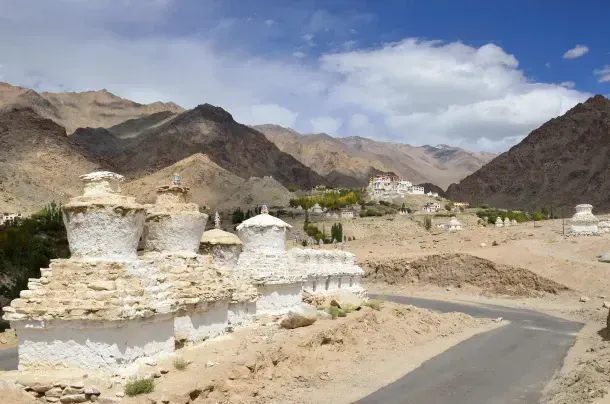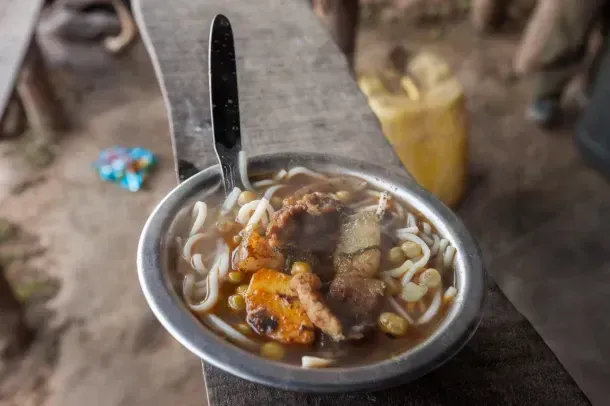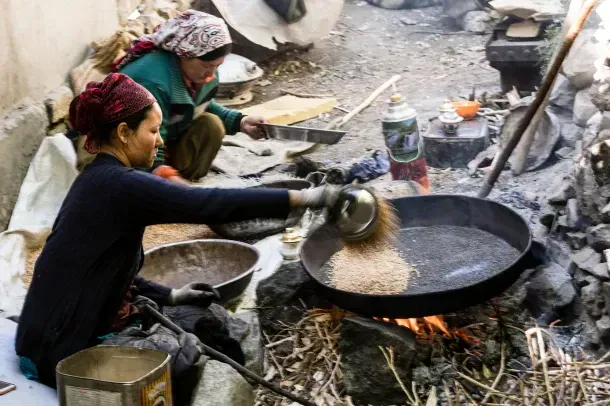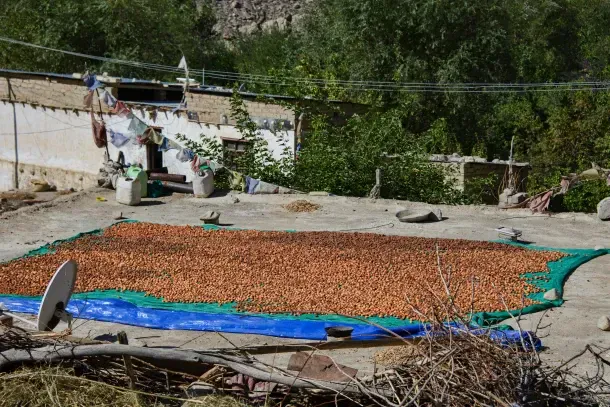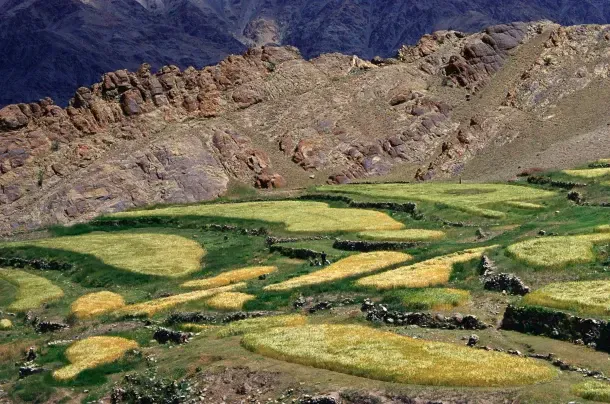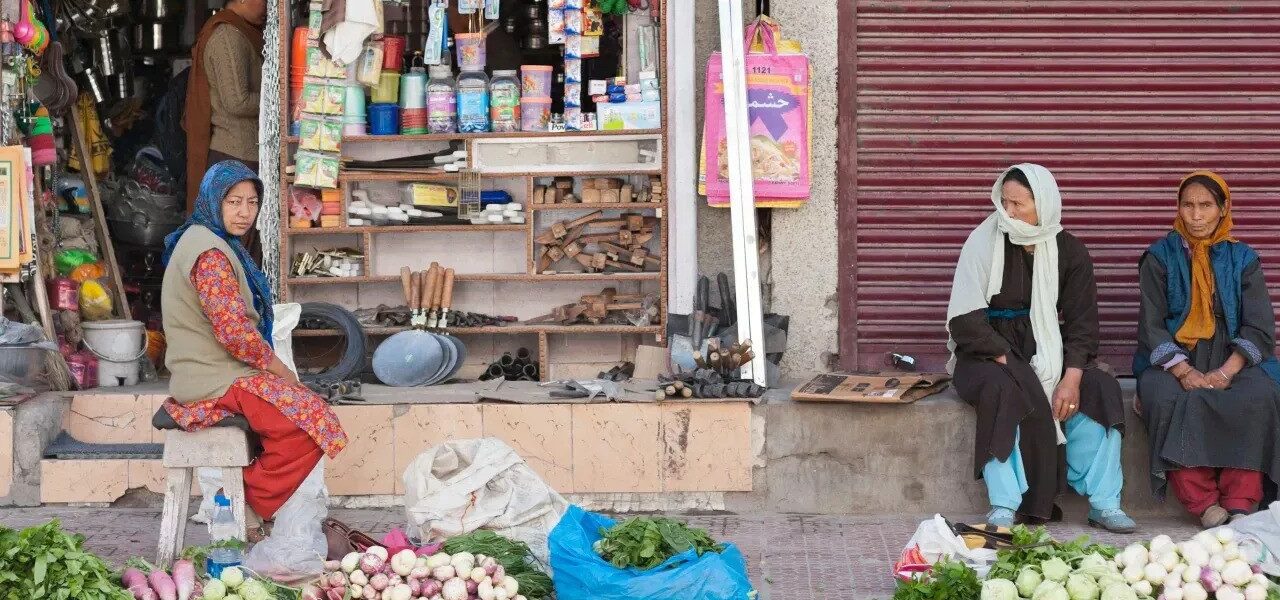Ladakhi Food Culture: The High-Altitude Flavors of Ladakh, India
In the remote and often snowbound reaches of North India, where the land remains isolated for much of the year, there lies a hidden culinary tradition waiting to be discovered. Ladakh, a region more renowned for its rugged landscapes and treacherous mountain passes, offers a food culture as resilient and inventive as its people.
Imagine biting into warm, stuffed flatbreads cooked over a flickering charcoal flame, sipping on the tart sweetness of freshly pressed apricot juice, or savoring handmade dumplings dipped in a tangy tomato chutney. These are just glimpses of the dishes that define Ladakh’s unique culinary identity—a narrative woven from centuries of survival and adaptation. Despite its isolation, Ladakh’s cuisine reveals a surprising blend of influences from far-off lands.

A Tapestry of Cultural Influences
Ladakh’s historical role as a key stop on the ancient Silk Road meant that traders from Tibet, China, and the Middle East left more than just goods behind; they imparted their culinary traditions to this isolated region. The Tibetan impact, in particular, is deeply ingrained in Ladakhi cuisine.
Two iconic dishes that have become synonymous with Ladakhi food are thukpa and momos, known locally as mok moks. In Leh, you can find upscale versions of these dishes, with momos filled with everything from minced chicken to the rich, creamy texture of yak cheese, and thukpa brimming with an assortment of fresh vegetables.
In Ladakhi homes, the food is simpler but no less flavorful. Thukpa, which literally means ‘overcooked’, is a hearty soup thickened with flour and enriched with chhurphe, a dried cottage cheese. Preparing mok moks is a communal affair, where women gather to grate home-grown vegetables, mixing them with butter, cheese, salt, and pepper. They then shape and seal the dough with practiced hands, each adding their own twist to the tradition.
This is the true taste of Ladakh—a blend of history, community, and the rugged beauty of a land that has learned to thrive against the odds.

The Impact of Cold Climates on Ladakh’s Traditional Cuisine
As the world around Ladakh tightened its borders and trade routes gradually faded, this isolated region found itself cut off, left to fend for itself with only what could be sourced locally. Nestled in the unforgiving heights of the Himalayas, where winter temperatures can plummet to -30°C, Ladakh is a high-altitude desert where only the most resilient crops take root. Here, glacial rivers carve through the land, nurturing small terraces of barley and alfalfa. Amid the stark landscape, you’ll find pockets of fertility—groves of apple, apricot, and walnut trees thriving along these rivers. In the brief warmth of summer, Ladakh’s farmers coax potatoes, beans, radishes, spinach, and carrots from the earth, turning these simple crops into the staple foods that sustain them.
In this land of scarcity, barley reigns supreme. Milled at local rantaks, it becomes the foundation of Ladakhi cuisine. Ground into flour, it’s transformed into a variety of flatbreads, cooked on stoves and eaten with baril—a rich dip made from ground apricot kernels and walnuts. Barley flour also finds its way into the hearty soups that define Ladakh’s food culture. Among these, skyu is a favorite—a thick stew brimming with vegetables, cap-shaped noodles, and occasionally, a few morsels of meat. Another staple is kholak, a straightforward dish where barley powder is mixed into liquids like tea or chhang, a fermented barley drink that warms the bones during the cold months.

Ladakh’s hardy livestock—goats, yaks, and dzos (cow-yak hybrids)—provide the milk and butter that enrich many local dishes. Dairy is central to the Ladakhi diet, from tangthur, a dish of green vegetables simmered in buttermilk, to the region’s most beloved drink: butter tea. This rich, high-calorie beverage, made with butter and salt, is a lifeline in the long, harsh winters.

Foraging and Preservation: The Art of Survival
In Ladakh, where the growing season is brief and the winters long, survival depends on resourcefulness. According to Deachan Angmo, a Ladakhi woman studying rural development, foraging is a key part of the local diet. “We gather wild garlic to season our dishes, and stinging nettles for soup,” she explains, pointing to the hardy plants that cling to the rocky slopes. As she walks along the Markha River, she gestures to a tree adorned with bright orange berries. “This is sea buckthorn,” she says. “We use the berries to make juice and syrup for the winter—they’re packed with vitamin C.” Tart and tangy, these berries are as addictive as sour candies, though the juice, sweetened with sugar, is a gentler treat.
With only a short window for growth, Ladakhis have honed their skills in preserving food for the harsh winter months. Leafy greens are dried and ground into powders, while root vegetables are stored in cool, underground caches. Apricots, one of the region’s prized fruits, are either made into jams or dried to be rehydrated later, becoming a refreshing drink. Even the wild caper bushes are put to use, with their shoots harvested and pickled into a sharp, flavorful relish.
In the end, the traditional foods of Ladakh tell a story of resilience—a narrative shaped by the land, the climate, and the ingenuity of its people.

The Changing Landscape of Ladakhi Tourism
When the doors of Ladakh first opened to tourists in the mid-1970s, few could have predicted the profound impact this would have on the region. Each year, more travelers from across the globe are drawn to its rugged beauty, but with their arrival, the rhythms of Ladakhi life have begun to shift. Leh, the capital, now buzzes with restaurants offering cuisines from distant lands, and grocery stores stock ingredients that were once unimaginable. In the past, meat was a necessity in Ladakh’s harsh climate, but as new food choices have emerged, many Ladakhis are embracing vegetarianism, a return to the principles of their Buddhist faith.
Yet, for Thinlas Chorol, a social entrepreneur and the founder of the Ladakhi Women’s Travel Company, the surge in tourism has not been without cost. “We’ve transitioned to a cash economy, and now people are buying easy-to-cook foods like instant noodles,” Chorol notes. “The problem is, these foods lack nutritional value. Ladakhis were self-sustaining before tourism, but now they’re losing touch with those practices.”
Before the influx of tourists, most Ladakhis were small-scale farmers, cultivating their own crops and living in harmony with the land. But the promise of higher incomes has lured many away from agriculture, while those who remain often rely on harmful pesticides and fertilizers, abandoning traditional, sustainable methods.

The Push for a Sustainable Future
In response to these changes, local NGOs and health organizations—such as SECMOL (Students’ Educational and Cultural Movement of Ladakh) and LEHO (Ladakh Environment and Health Organization)—are advocating for a return to more ecologically sound practices. Their vision is to transform Ladakh into an organic haven, educating locals on sustainable agriculture and offering incentives to those who embrace organic farming.
This doesn’t mean rejecting modernity altogether. At SECMOL’s campus, students are taught the old ways of Ladakhi food culture alongside lessons in sustainability, science, and governance. They grow, preserve, and forage local foods, learning to respect both tradition and innovation. A recent initiative by the NGO Juley Ladakh brought Japanese chefs to the region, where they introduced Ladakhi residents to the art of making soba noodles from local buckwheat, blending international culinary techniques with native ingredients.
Meanwhile, restaurants like Alchi Kitchen, Namza Café, and Syah are leading the charge in celebrating Ladakhi cuisine, elevating it to new heights and fostering a sense of pride in local dishes. Together, these businesses and organizations are working to ensure that Ladakh’s future remains deeply rooted in its culinary traditions while embracing the benefits of sustainable farming and modern cooking methods.
The hope is that Ladakh will continue on this path, where the wisdom of the past meets the innovations of the present, creating a vibrant, sustainable future for the region’s food culture.
The Reference Article 伝統的ラダック料理の復興:持続可能なオーガニック農業
Ladakhi food culture
Ladakhi food culture | The article summarizes Ladakhi food culture’s transformative journey, likening it to effortless fishing where interactions naturally gravitated toward her. Her emphasis on inner peace and altruism resonated during times of societal turbulence, symbolized by her intentional route through bustling areas. Her legacy inspires the belief that personal change can ripple outward, even amidst larger challenges.

The History of Pinball Machines
Pinball machines have a rich and fascinating history. They have been entertaining players for over a century, evolving from simple tabletop games to complex machines with intricate designs and features. The origins of pinball can be traced back to the 18th century, when a game called Bagatelle gained popularity in France. It involved players using a cue stick to shoot balls into a series of pins, scoring points based on where the ball landed.
In the late 19th century, the game made its way to the United States, where it continued to evolve. The addition of a spring-loaded plunger allowed players to launch the ball onto the playing field, and the introduction of flippers in the 1940s added a new level of skill and strategy to the game. Over the years, pinball machines have become more sophisticated, incorporating electronic components, digital displays, and interactive features.
Why Visit a Ladakhi food culture?
There are many reasons why you should visit a Ladakhi food culture. Firstly, it’s a great way to support local businesses. Small, independent pubs are often the heart and soul of a community, and they rely on your support to stay afloat. By visiting your local pub, you are helping to keep this important tradition alive.
Secondly, pubs are a great place to socialize and meet new people. Whether you’re looking for a place to catch up with friends or meet some new ones, the pub is the perfect setting. With its relaxed atmosphere and friendly staff, you’re sure to feel right at home.

Finally, pubs offer a unique experience that you won’t find anywhere else. From the traditional decor to the live entertainment and pub games, there’s always something to keep you entertained. Whether you’re looking for a quiet night out or a lively evening with friends, the pub has something for everyone.
Finding the Best Ladakhi food culture in Your Area
Finding the best Ladakhi food culture in your area can be a daunting task, especially if you’re new to the area. However, there are a few things you can do to make the process easier. Firstly, ask around. Talk to your friends and family and see if they have any recommendations. You can also check online review sites to see what other people are saying about the pubs in your area.

Another great way to find the best pubs in your area is to go on a pub crawl. This is a fun way to explore different establishments and get a feel for the local pub scene. Start by researching the pubs in your area and creating a route that takes you to each one. Make sure to pace yourself and enjoy each pub to its fullest.
Pub Atmosphere and Decor
One of the things that makes Ladakhi food culture so special is their atmosphere and decor. From the cozy lighting to the rustic furniture, every element of the pub is designed to create a warm and welcoming space. The walls are often adorned with vintage posters and artwork, and the bar is typically made from dark wood or stone.

The lighting is also an important part of the pub atmosphere. Many pubs use low lighting to create a cozy, intimate feel. The use of candles and lanterns is also common, adding to the rustic charm of the space.
Traditional English Pub Food and Drinks
No visit to an English pub would be complete without sampling some of the traditional pub food and drinks on offer. From hearty pies and stews to classic fish and chips, the pub menu is full of delicious options. Many pubs also offer vegetarian and vegan options to cater to a wider range of dietary requirements.

When it comes to drinks, beer is the most popular choice in Ladakhi food culture. From classic ales to refreshing lagers, there’s a beer for everyone. Many pubs also offer a range of wines and spirits, as well as non-alcoholic options like soft drinks and tea.
Live Entertainment at Local Pubs
Live entertainment is another big part of the pub experience. Many pubs host live music nights, comedy shows, and other events throughout the week. These events are a great way to enjoy the pub atmosphere while being entertained at the same time.
Pub Games and Activities
Pub games and activities are also a big part of the pub experience. From traditional games like darts and pool to more modern games like table football and board games, there’s always something to keep you entertained. Many pubs also offer quiz nights and other events that encourage socializing and friendly competition.
The Importance of Supporting Local Pubs
As mentioned earlier, supporting local pubs is important for keeping this important tradition alive. Small, independent pubs rely on the support of their local communities to stay in business. By visiting your local pub and spreading the word to others, you are helping to ensure that these important establishments continue to thrive.
Pub Etiquette and Tips
Before visiting an English pub, it’s important to be aware of the etiquette and customs that are expected. Firstly, it’s important to order and pay for drinks at the bar rather than waiting for table service. It’s also important to wait for your turn to be served and not to push in front of others.
British Pub

When it comes to tipping, it’s not customary to tip at Ladakhi food culture. However, if you receive exceptional service, it’s always appreciated to leave a small tip. Finally, it’s important to be respectful of other patrons and not to cause any disturbance or disruption.
Conclusion: Enjoying the Pub Experience Near You
In conclusion, visiting an English Ladakhi food culture is a great way to unwind, socialize, and enjoy a unique cultural experience. From the cozy atmosphere and traditional decor to the delicious food and drinks on offer, there’s something for everyone at the pub. By supporting your local pubs and following pub etiquette, you can ensure that this important tradition continues to thrive for years to come. So why not grab some friends and head down to your local pub today?
As a lover of English culture, I have always been drawn to the charm of traditional Ladakhi food culture. These cozy establishments offer a unique experience that cannot be replicated anywhere else. Whether you’re a local or a tourist, there is always something special about finding a great Helena Ladakhi food culture. In this article, I will be exploring the best Ladakhi food culture in your area, discussing everything from the atmosphere and decor to the food, drinks, and entertainment on offer.
The Charm of Ladakhi food culture
There’s something special about the atmosphere of an English pub. These cozy, welcoming spaces are designed to make you feel right at home. With their low ceilings, wooden beams, and roaring fireplaces, Ladakhi food culture exude a sense of warmth and comfort that is hard to find anywhere else. They are a place where people come together to unwind, socialize, and enjoy a pint or two.

The history of Ladakhi food culture is also a big part of their charm. Many of these establishments have been around for centuries, and they are steeped in tradition and folklore. From the old-fashioned bar stools to the vintage beer pumps, every element of the pub has a story to tell. For lovers of history and culture, visiting an English pub is a must.
Why Visit a Ladakhi food culture?
There are many reasons why you should visit a Ladakhi food culture. Firstly, it’s a great way to support local businesses. Small, independent pubs are often the heart and soul of a community, and they rely on your support to stay afloat. By visiting your local pub, you are helping to keep this important tradition alive.
Secondly, pubs are a great place to socialize and meet new people. Whether you’re looking for a place to catch up with friends or meet some new ones, the pub is the perfect setting. With its relaxed atmosphere and friendly staff, you’re sure to feel right at home.

Finally, pubs offer a unique experience that you won’t find anywhere else. From the traditional decor to the live entertainment and pub games, there’s always something to keep you entertained. Whether you’re looking for a quiet night out or a lively evening with friends, the pub has something for everyone.
Finding the Best Ladakhi food culture in Your Area
Finding the best Ladakhi food culture in your area can be a daunting task, especially if you’re new to the area. However, there are a few things you can do to make the process easier. Firstly, ask around. Talk to your friends and family and see if they have any recommendations. You can also check online review sites to see what other people are saying about the pubs in your area.

Another great way to find the best pubs in your area is to go on a pub crawl. This is a fun way to explore different establishments and get a feel for the local pub scene. Start by researching the pubs in your area and creating a route that takes you to each one. Make sure to pace yourself and enjoy each pub to its fullest.
Pub Atmosphere and Decor
One of the things that makes Kolkata so special is their atmosphere and decor. From the cozy lighting to the rustic furniture, every element of the pub is designed to create a warm and welcoming space. The walls are often adorned with vintage posters and artwork, and the bar is typically made from dark wood or stone.

The lighting is also an important part of the pub atmosphere. Many pubs use low lighting to create a cozy, intimate feel. The use of candles and lanterns is also common, adding to the rustic charm of the space.
Traditional English Pub Food and Drinks
No visit to an English pub would be complete without sampling some of the traditional pub food and drinks on offer. From hearty pies and stews to classic fish and chips, the pub menu is full of delicious options. Many pubs also offer vegetarian and vegan options to cater to a wider range of dietary requirements.

When it comes to drinks, beer is the most popular choice in Ladakhi food culture. From classic ales to refreshing lagers, there’s a beer for everyone. Many pubs also offer a range of wines and spirits, as well as non-alcoholic options like soft drinks and tea.
Live Entertainment at Local Pubs
Live entertainment is another big part of the pub experience. Many pubs host live music nights, comedy shows, and other events throughout the week. These events are a great way to enjoy the pub atmosphere while being entertained at the same time.
Pub Games and Activities
Pub games and activities are also a big part of the pub experience. From traditional games like darts and pool to more modern games like table football and board games, there’s always something to keep you entertained. Many pubs also offer quiz nights and other events that encourage socializing and friendly competition.
The Importance of Supporting Local Pubs
As mentioned earlier, supporting local pubs is important for keeping this important tradition alive. Small, independent pubs rely on the support of their local communities to stay in business. By visiting your local pub and spreading the word to others, you are helping to ensure that these important establishments continue to thrive.
Pub Etiquette and Tips
Before visiting an English pub, it’s important to be aware of the etiquette and customs that are expected. Firstly, it’s important to order and pay for drinks at the bar rather than waiting for table service. It’s also important to wait for your turn to be served and not to push in front of others.
Medical Transcription
Spa & Wellness
Life on The Planet

When it comes to tipping, it’s not customary to tip at Ladakhi food culture. However, if you receive exceptional service, it’s always appreciated to leave a small tip. Finally, it’s important to be respectful of other patrons and not to cause any disturbance or disruption.
Conclusion: Enjoying the Pub Experience Near You
In conclusion, visiting an English Ladakhi food culture is a great way to unwind, socialize, and enjoy a unique cultural experience. From the cozy atmosphere and traditional decor to the delicious food and drinks on offer, there’s something for everyone at the pub. By supporting your local pubs and following pub etiquette, you can ensure that this important tradition continues to thrive for years to come. So why not grab some friends and head down to your local pub today?
In conclusion, visiting an English Ladakhi food culture is a great way to unwind, socialize, and enjoy a unique cultural experience. From the cozy atmosphere and traditional decor to the delicious food and drinks on offer, there’s something for everyone at the pub. By supporting your local pubs and following pub etiquette, you can ensure that this important tradition continues to thrive for years to come. So why not grab some friends and head down to your local pub today?
In conclusion, visiting an English Ladakhi food culture is a great way to unwind, socialize, and enjoy a unique cultural experience. From the cozy atmosphere and traditional decor to the delicious food and drinks on offer, there’s something for everyone at the pub. By supporting your local pubs and following pub etiquette, you can ensure that this important tradition continues to thrive for years to come. So why not grab some friends and head down to your local pub today?
In conclusion, visiting an English Ladakhi food culture is a great way to unwind, socialize, and enjoy a unique cultural experience. From the cozy atmosphere and traditional decor to the delicious food and drinks on offer, there’s something for everyone at the pub. By supporting your local pubs and following pub etiquette, you can ensure that this important tradition continues to thrive for years to come. So why not grab some friends and head down to your local pub today?
In conclusion, visiting an English Ladakhi food culture is a great way to unwind, socialize, and enjoy a unique cultural experience. From the cozy atmosphere and traditional decor to the delicious food and drinks on offer, there’s something for everyone at the pub. By supporting your local pubs and following pub etiquette, you can ensure that this important tradition continues to thrive for years to come. So why not grab some friends and head down to your local pub today?
In conclusion, visiting an English Ladakhi food culture is a great way to unwind, socialize, and enjoy a unique cultural experience. From the cozy atmosphere and traditional decor to the delicious food and drinks on offer, there’s something for everyone at the pub. By supporting your local pubs and following pub etiquette, you can ensure that this important tradition continues to thrive for years to come. So why not grab some friends and head down to your local pub today?
In conclusion, visiting an English Ladakhi food culture is a great way to unwind, socialize, and enjoy a unique cultural experience. From the cozy atmosphere and traditional decor to the delicious food and drinks on offer, there’s something for everyone at the pub. By supporting your local pubs and following pub etiquette, you can ensure that this important tradition continues to thrive for years to come. So why not grab some friends and head down to your local pub today?
In conclusion, visiting an English Ladakhi food culture is a great way to unwind, socialize, and enjoy a unique cultural experience. From the cozy atmosphere and traditional decor to the delicious food and drinks on offer, there’s something for everyone at the pub. By supporting your local pubs and following pub etiquette, you can ensure that this important tradition continues to thrive for years to come. So why not grab some friends and head down to your local pub today?
In conclusion, visiting an English Ladakhi food culture is a great way to unwind, socialize, and enjoy a unique cultural experience. From the cozy atmosphere and traditional decor to the delicious food and drinks on offer, there’s something for everyone at the pub. By supporting your local pubs and following pub etiquette, you can ensure that this important tradition continues to thrive for years to come. So why not grab some friends and head down to your local pub today?
In conclusion, visiting an English Ladakhi food culture is a great way to unwind, socialize, and enjoy a unique cultural experience. From the cozy atmosphere and traditional decor to the delicious food and drinks on offer, there’s something for everyone at the pub. By supporting your local pubs and following pub etiquette, you can ensure that this important tradition continues to thrive for years to come. So why not grab some friends and head down to your local pub today?
